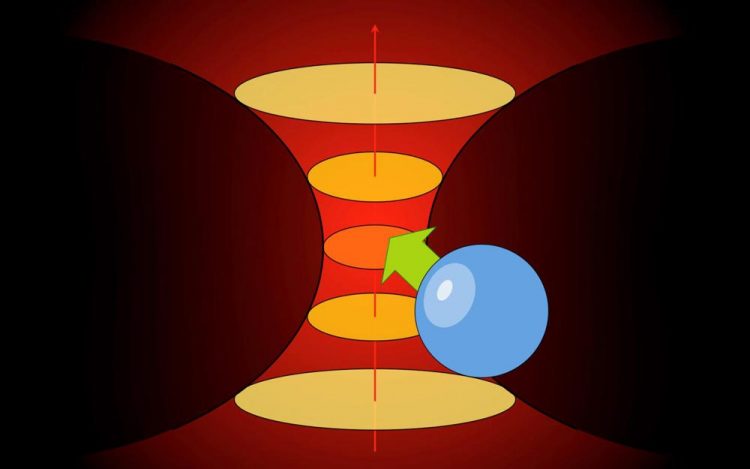A new force for optical tweezers awakens

Illustration of an optical tweezer Credit: Giovanni Volpe
“We call it 'intra-cavity feedback force'. The basic idea is that, depending on where the particle or cell you want to study is, the amount of laser light used to trap it changes automatically. Whenever the particle is in focus, the laser switches off. When the particle tries to escape, the laser switches on again”, says Giovanny Volpe, senior lecturer at the Department of Physics, University of Gothenburg.
An optical tweezer is a focused laser beam that can trap particles. Previously, two different types of forces that emerge from this type of tool have been identified: gradient force (which means the particle goes against the intensity of the laser) and scattering force (where the particle is pushed towards the laser).
Giovanni Volpe and his team have discovered a third type of force in this realm, and a new way of constructing optical tweezers. These break-throughs are poised to greatly improve the study of single biological cells.
“With this method, as much as 100 times less light is needed, in some cases, compared to using a traditional optical tweezer,” Giovanni Volpe explains. “With less light, you cause less photo damage to the cell you are studying.”
This could be useful for studying any cell that is usually suspended in a solution – a blood cell or a yeast cell, for example – that a researcher would want to study over a long period of time.
“One of the main issues when using optical tweezers is that the light raises the temperature of the cell, which is damaging. A rise of 10 degrees might not be tolerable, but the rise of 0,1 degrees might be fine.
So using less light, and therefore limiting the rise in temperature, could make a huge difference. Experiments could be done in a more realistic manner in relation to the cell's natural life cycle,” says Giovanni Volpe.
###
The findings are published in Nature Communications.
Title: “Intracavity optical trapping of microscopic particles in a ring-cavity fiber laser”
Link: https:/
Media Contact
All latest news from the category: Physics and Astronomy
This area deals with the fundamental laws and building blocks of nature and how they interact, the properties and the behavior of matter, and research into space and time and their structures.
innovations-report provides in-depth reports and articles on subjects such as astrophysics, laser technologies, nuclear, quantum, particle and solid-state physics, nanotechnologies, planetary research and findings (Mars, Venus) and developments related to the Hubble Telescope.
Newest articles

NASA: Mystery of life’s handedness deepens
The mystery of why life uses molecules with specific orientations has deepened with a NASA-funded discovery that RNA — a key molecule thought to have potentially held the instructions for…

What are the effects of historic lithium mining on water quality?
Study reveals low levels of common contaminants but high levels of other elements in waters associated with an abandoned lithium mine. Lithium ore and mining waste from a historic lithium…

Quantum-inspired design boosts efficiency of heat-to-electricity conversion
Rice engineers take unconventional route to improving thermophotovoltaic systems. Researchers at Rice University have found a new way to improve a key element of thermophotovoltaic (TPV) systems, which convert heat…



